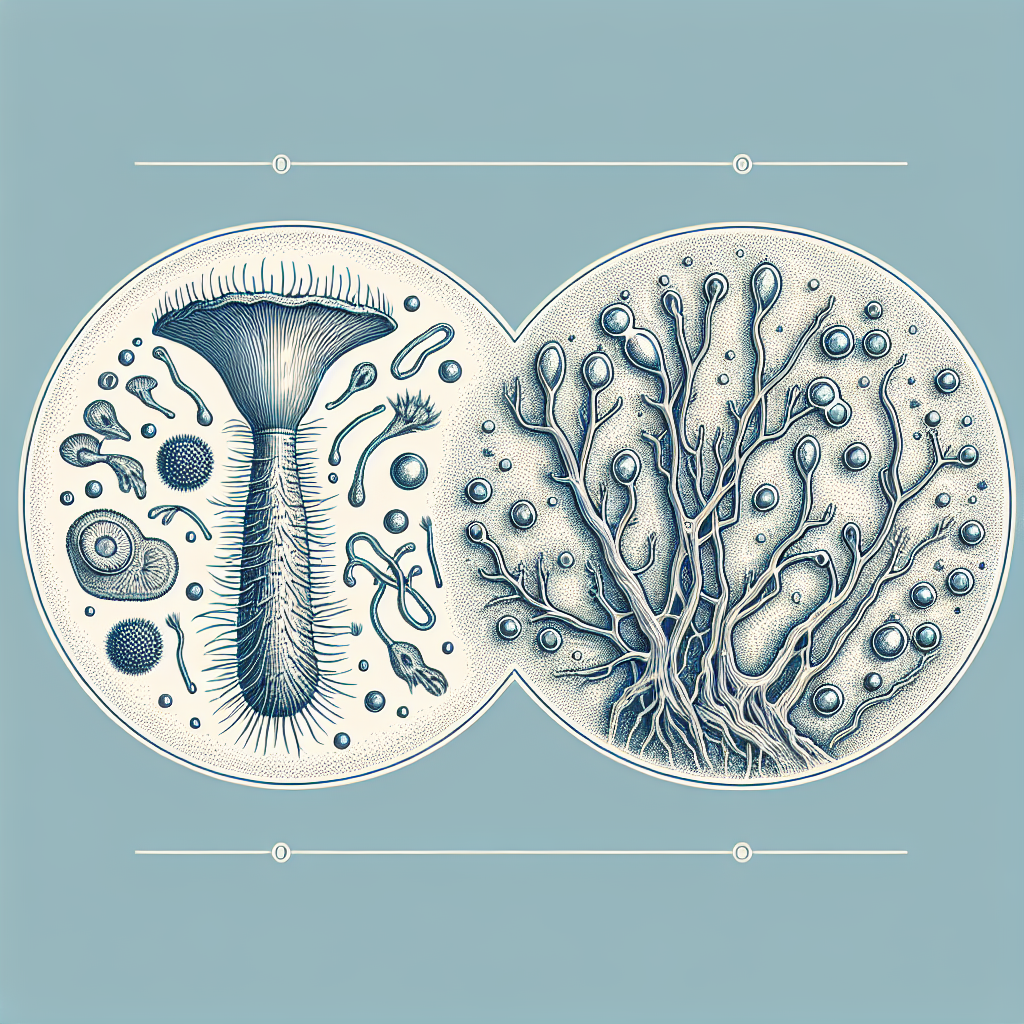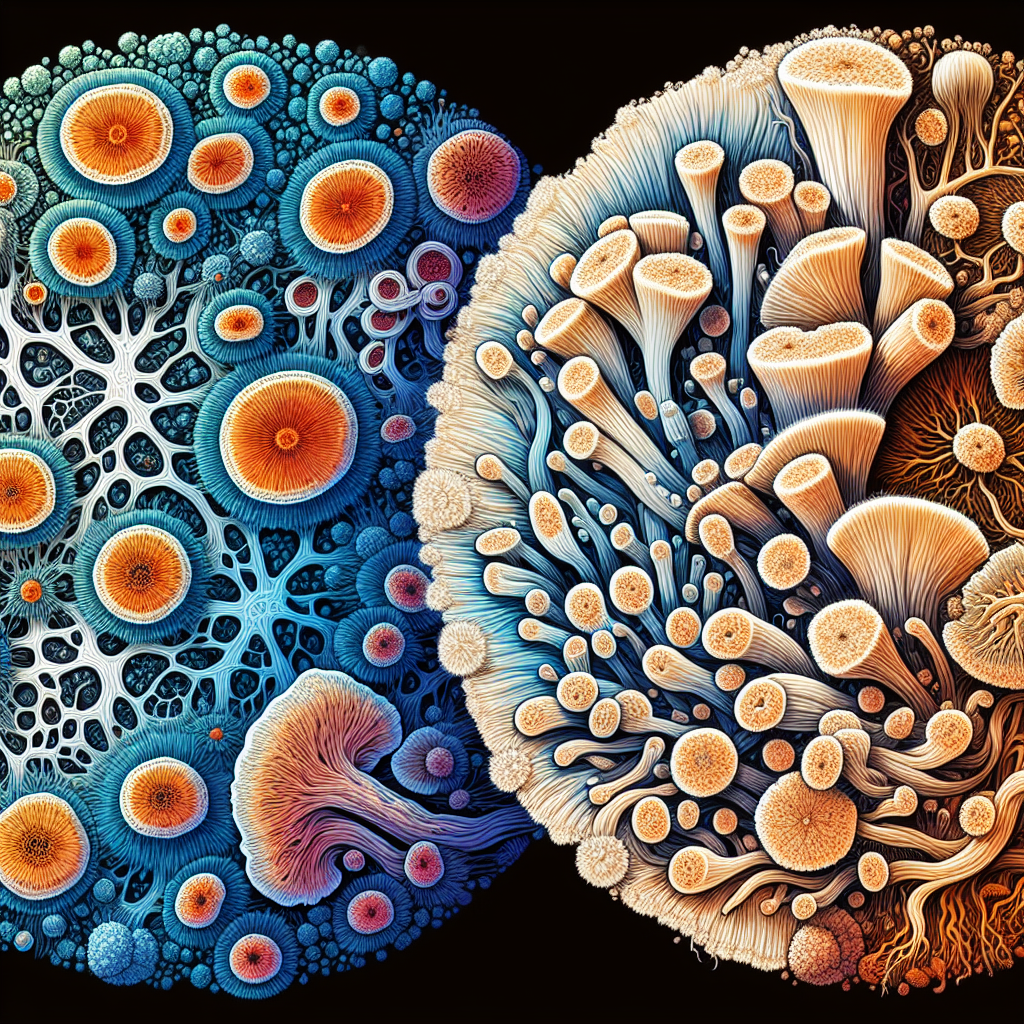Navigating the complex world of fungal biology may appear daunting initially, but with the right guidance, this intricacy transforms into awe-inspiring knowledge. You are about to embark on a journey, revealing two critical components found within this kingdom: Trichoderma (Trich) and Mycelium. This article, “Understanding the Differences: Trich vs Mycelium,” will provide you with a comprehensive comparison outlining their unique characteristics, functions, and roles in the ecosystem. Through this exploration, you will gain valuable insights into their distinctions, fostering deeper comprehension and appreciation for these underestimated yet fundamental elements of nature.

Fundamentals of Trichoderma
What is Trichoderma?
Trichoderma is a genus of fungi that is frequently located in various environments throughout the world. Possessing a complex life cycle, it is an essential component of soil microflora and is known for its rapid growth speed. They are characterized by their green conidia and have a reputation as effective biocontrol agents against myriad plant pathogens.
Types of Trichoderma
Numerous species of Trichoderma exist, which vary drastically in their morphology, enzyme production, and capability to resist antifungal compounds. Some common ones include Trichoderma harzianum, Trichoderma viride, and Trichoderma reesei, each having their own unique attributes and uses. Their inherent diversity signifies the expansive potential for their utilization in distinct spheres.
Physiological Roles of Trichoderma
Trichoderma fungi play an array of roles within their ecosystems. Principal among these are nutrient cycling and disease suppression. As omnivorous decomposers, they are integral in breaking down organic matter to facilitate nutrient flow in an ecosystem. Their aptitude in biocontrol stems from their ability to produce potent mycoparasitic enzymes, antagonising and inhibiting adverse pathogens.
Basic Understanding of Mycelium
Definition of Mycelium
Mycelium constitutes the vegetative part of a fungus. It is a network of fine white filaments, or hyphae, that penetrate the growth substrate—whether that be soil, wood, or another material. These compacted structures function as the primary mechanisms for nutrient absorption and growth for fungi.
Characterization of Mycelium
Mycelium is typically characterized by its web-like structure, known for its capacity to colonize enormous territories. It may appear in operational modes, like generative mycelium, which is thin, highly-branched, and efficient at acquiring nutrients; or resting mycelium, which is thicker, less branched, but more resilient to adverse conditions.
Functional Importance of Mycelium
The mycelium is vital for the continued existence of fungi. Not only does it provide the framework for growth and reproduction, but it also plays an indispensable role in nutrient acquisition and transport. Beyond this, it aids decomposition, leading to soil enrichment, and has vast potential in sustainable technology.
Growth Cycle of Trichoderma
The Stages of Trichoderma Development
Trichoderma’s life cycle consists of spore germination, mycelial phase, and sporulation. Spore germination starts once the spore lands on a convenient substrate. The mycelial phase is where vegetative growth occurs as the fungus spreads across the substrate. Lastly, under certain conditions, the fungus sporulates producing fresh conidia.
Factors Affecting Trichoderma Growth
Numerous factors play into the growth of Trichoderma. These range from temperature, pH, and type of substrate. Generally, they prefer warm, humid conditions around a mildly acidic pH. The presence of specific substrates, like simple sugars or other organic material, can also enhance their growth.
Impact of Environment on Trichoderma
Environmental factors influence the growth and behavior of Trichoderma species. Climatic conditions, abiotic stress, and the presence of other organisms can induce changes in the metabolic and physiological responses of Trichoderma. Their robustness allows them to thrive under varying conditions and they can adapt to diverse environments.
Mycelium Growth Patterns
Life Cycle of Mycelium
The life cycle of mycelium begins with the germination of a spore which, under favorable conditions, grows into a hypha. hyphae extend and intertwine to form the mycelial network. Due to its indeterminate growth, it can continuously expand, securing new resources for cell proliferation and survival.
Environmental Influences on Mycelium
The environment greatly influences the structure, growth, and behavior of mycelium. Factors like substrate availability, moisture, temperature, and competing organisms influence its growth. The ability to adapt to these environmental variables underscores the ecological success of fungi.
Effect of Nutritional Resources on Mycelium
The presence and form of nutritional resources impact the growth pattern of mycelium. Nutrient-rich substrates often lead to more structured, centralized growth, while nutrient-poor conditions result in a more extended, explorative growth to maximize resource discovery.

Morphological Differences between Trichoderma and Mycelium
Comparative Overview of Structures
Trichoderma, as a type of fungi, also contains mycelium as part of its structure. The critical difference lies in that Trichoderma is a specific organism, while mycelium is a component of fungal organisms. Trichoderma produces green conidia, while mycelium lacks any color and remains white.
Distinct Traits seen in Trichoderma
Trichoderma species exhibit distinctive characteristics based on morphology, conidiation patterns, enzyme production, and resistance to antimycotics. They are recognized by their verticillium-like branching pattern that results in a tuft of conidiophores, the structures producing green conidia.
Characteristics unique to Mycelium
Mycelium possesses its unique traits, including a high surface-area-to-volume ratio for effective nutrient absorption, versatility in overcoming physical barriers, and resilience to adverse conditions. Its ramified structure allows it to spread across large territories, making it key for resource acquisition in fungi.
Genetic Differences between Trichoderma and Mycelium
Genetic Variations of Trichoderma
The various species of Trichoderma show high genetic diversity. Each species harbors unique sets of genes responsible for their distinct physiological characteristics, biocontrol properties, and survival techniques. Advances in genomics have identified multiple genes linked to Trichoderma traits, such as fast growth, mycoparasitism, and enzyme production.
Genetic Composition of Mycelium
The genetic composition of mycelium corresponds to the specific species of fungi it belongs to. Inside the network of hyphae, each cell holds multiple nuclei that possess identical genetic material. The genetic makeup of mycelium drives its branching growth pattern, tolerance to environmental conditions, and capacity to form different structures like fruit bodies or spores.
Identification of Genetic Divergences
While the species-specific nature of their genes is evident, the primary divergence lies in unique gene sets in Trichoderma vs. the entire genetic make-up in mycelium. Genetic profiling techniques, such as DNA sequencing, can reveal variances and commonalities in their genetic material, providing insight into their disease resistance and functional traits.
Disease Susceptibility: Trichoderma vs Mycelium
Trichoderma and its Response to Pathogens
Trichoderma exhibits effective defense mechanisms against a host of pathogens. Owing to its competitive saprophytism, antibiosis abilities, and mycoparasitism, it proves to be a successful biocontrol agent. Certain Trichoderma species produce antifungal compounds that inhibit the growth of various pathogens, ensuring their survival and dominance in their niche.
Mycelium and Disease Resistance
Mycelium’s disease resistance is also species-specific; however, some general strategies are employed across the fungi kingdom. These include the production of antimicrobial compounds, competition for resources, deploying physical barriers, and forming compatibility reactions. This resistance capacity is encoded in mycelium’s genetic material and is critical for its protection and survival.
Understanding the Defense Mechanisms
Understanding the defense mechanisms of both Trichoderma and mycelium offers opportunities for biocontrol and enforcement of their natural defenses. This insight can enrich the development of sustainable agricultural practices, minimizing dependence on artificial pesticides or fertilizers.
Ecological Roles: Trichoderma vs Mycelium
Ecological Contribution of Trichoderma
Trichoderma contributes to ecosystem functioning through pathogen control and nutrient cycling. By inhibiting harmful pathogens, they promote healthier plant communities. Their decomposition capacity supports nutrient cycling, enhancing soil fertility, and thereby, supporting surrounding life.
Ecosystem Value of Mycelium
Mycelium benefits the ecosystem in numerous ways, fulfilling roles in nutrient cycling, decomposition, and symbiotic relationships with plants. As a primary decomposer, it breaks down complex organic matter into simpler forms, contributing to soil fertility and structure. Also, through mycorrhizal relationships, mycelium aids plant nutrient and water uptake.
Comparative Analysis of their Roles
While both Trichoderma and mycelium hold indispensable roles in their ecosystems, their contributions can vary. Trichoderma as a biocontrol agent directly impacts plant health, while mycelium’s extensive roles support soil health, plant life, and overall ecosystem equilibrium. The understanding of their ecological roles is crucial for fostering sustainable environmental practices.
Cultivation Considerations for Trichoderma and Mycelium
Cultivation Practices for Trichoderma
Trichoderma cultivation involves providing appropriate substrates, optimal temperature, and moisture conditions for them to thrive. The choice of substrate often depends on the targeted application. For instance, agricultural applications may use compost or other organic material to facilitate growth.
Optimal Conditions for Mycelium Growth
successful mycelium cultivation requires adequate control of environmental factors such as moisture, temperature, pH, and access to nutrients. Availability of a suitable substrate, such as grain, straw, or wood, is crucial as well. The selection depends on the specific species and the intended use of mycelium.
Challenges in Cultivation and Distinct Solutions
Cultivating Trichoderma and mycelium comes with inherent challenges, such as managing contamination, meeting specific growth requirements, and optimizing yields. These challenges can be addressed through sterile cultivation techniques, adjusting environmental parameters, and using nutrient-rich substrates to support growth and proliferation.
Practical Usage and Applications: Trichoderma vs Mycelium
Industries Benefiting from Trichoderma
Trichoderma has found usage in numerous industries, most notably agriculture, where it serves as a biocontrol agent defending against plant diseases. In the enzyme industry, Trichoderma reesei is used to produce industrial cellulase. Additionally, it has potential in bioenergy production, as it can convert agricultural wastes into biofuels.
Mycelium in Commercial Products
Mycelium has far-reaching applications across various industries. In the construction industry, mycelium composites are used as an alternative to conventional building materials. In the food and beverage industry, mycelium is used in the production of fermented products. Moreover, it has promising usage in waste management and bioremediation.
Pioneering Applications Based on Their Differences
The unique attributes of Trichoderma and mycelium are being harnessed based on their differences. By exploiting Trichoderma’s resistance to pathogens, there are innovative applications in agricultural biocontrol. Conversely, mycelium’s extensive network and decay resistance lend themselves to development in sustainable packaging, furniture, and even clothing. As the understanding of these remarkable organisms deepens, the potential for their application will continue to unfold.
